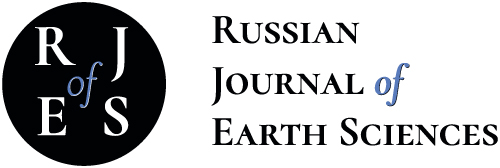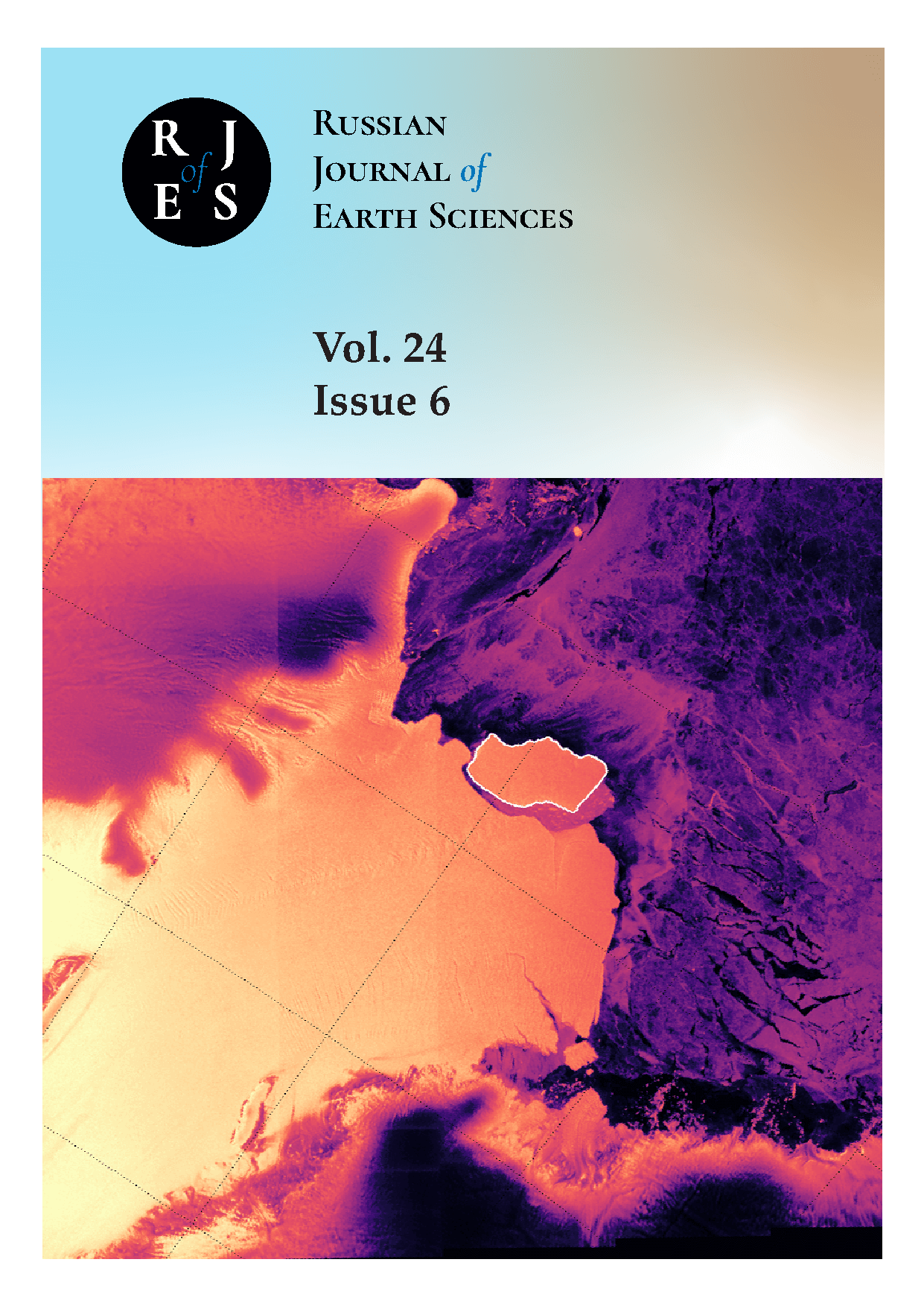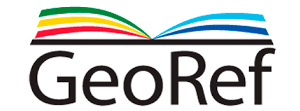Russian Federation
from 01.01.2021 until now
Korolev, Moscow, Russian Federation
Russian Federation
Moscow, Moscow, Russian Federation
VAK Russia 1.6
UDC 55
UDC 550.34
UDC 550.383
CSCSTI 37.25
CSCSTI 37.01
CSCSTI 37.15
CSCSTI 37.31
CSCSTI 38.01
CSCSTI 36.00
CSCSTI 37.00
CSCSTI 38.00
CSCSTI 39.00
CSCSTI 52.00
Russian Classification of Professions by Education 05.00.00
Russian Library and Bibliographic Classification 26
Russian Trade and Bibliographic Classification 63
BISAC SCI SCIENCE
The Vema Channel is a deep narrow passage in the South Atlantic and a main path for bottom water which flows northward from the Argentine Basin to the Brazil Basin and after all into the North Atlantic. The thermohaline structure and dynamics in it have been studied for many years. In this study we report our new data on dissolved oxygen and nutrients measurements performed in 2022 at the exit of the Vema Channel. This is the first time that such measurements have been made with high spatial resolution. Data from standard oceanographic sections located near the study area are also analyzed. A significant dependence in the distribution of dissolved oxygen and nutrients on the hydrological structure is shown. Local dissolved oxygen minimum indicates the lower boundary of Circumpolar waters. It was also revealed insignificant temporal variability of nutrients concentration.
Vema Channel, abyssal waters, dissolved oxygen, silicate, phosphate, nitrate
1. Álvarez, M., S. Brea, H. Mercier, and X. A. Álvarez Salgado (2014), Mineralization of biogenic materials in the water masses of the South Atlantic Ocean. I: Assessment and results of an optimum multiparameter analysis, Progress in Oceanography, 123, 1–23, https://doi.org/10.1016/j.pocean.2013.12.007.
2. Andrié, C., Y. Gouriou, B. Bourlès, et al. (2003), Variability of AABW properties in the equatorial channel at 35 ◦W, Geophysical Research Letters, 30(5), https://doi.org/10.1029/2002GL015766.
3. Boyer, T. P., O. K. Baranova, C. Coleman, et al. (2018), World Ocean Database 2018, NOAA Atlas NESDIS 87.
4. Campos, E. J. D., M. C. van Caspel, W. Zenk, et al. (2021), Warming Trend in Antarctic Bottom Water in the Vema Channel in the South Atlantic, Geophysical Research Letters, 48(19), https://doi.org/10.1029/2021GL094709. EDN: https://elibrary.ru/AKQORE
5. Carmack, E. C. (1973), Silicate and potential temperature in the deep and bottom waters of the western Weddell Sea, Deep Sea Research and Oceanographic Abstracts, 20(10), 927–932, https://doi.org/10.1016/0011-7471(73)90112-5.
6. Cartenter, J. H. (1965), The Chesapeake Bay Institute technique for the Winkler dissolved oxygen method, Limnology and Oceanography, 10(1), 141–143, https://doi.org/10.4319/lo.1965.10.1.0141.
7. Egbert, G. D., and S. Y. Erofeeva (2002), Efficient Inverse Modeling of Barotropic Ocean Tides, Journal of Atmospheric and Oceanic Technology, 19(2), 183–204, https://doi.org/10.1175/1520-0426(2002)019<0183:EIMOBO>2.0.CO;2.
8. Frey, D. I., V. V. Fomin, R. Y. Tarakanov, et al. (2018), Bottom Water Flows in the Vema Channel and over the Santos Plateau Based on the Field and Numerical Experiments, in The Ocean in Motion, pp. 475–485, Springer International Publishing, https://doi.org/10.1007/978-3-319-71934-4_29. EDN: https://elibrary.ru/SFFQOJ
9. Frey, D. I., E. G. Morozov, V. V. Fomin, et al. (2019), Regional Modeling of Antarctic Bottom Water Flows in the Key Passages of the Atlantic, Journal of Geophysical Research: Oceans, 124(11), 8414–8428, https://doi.org/10.1029/2019JC015315. EDN: https://elibrary.ru/RRGUPW
10. Frey, D. I., D. Borisov, V. Fomin, et al. (2022), Modeling of bottom currents for estimating their erosional-depositional potential in the Southwest Atlantic, Journal of Marine Systems, 230, 103,736, https://doi.org/10.1016/j.jmarsys.2022.103736. EDN: https://elibrary.ru/GLNTYU
11. Frey, D. I., E. G. Morozov, and D. A. Smirnova (2023), Sea level anomalies affect the ocean circulation at abyssal depths, Scientific Reports, 13(1), https://doi.org/10.1038/s41598-023-48074-9. EDN: https://elibrary.ru/DFZHBY
12. Gamboa, L. A., R. T. Buffler, and P. F. Barker (1983), Seismic Stratigraphy and Geologic History of the Rio Grande Gap and Southern Brazil Basin, in Initial Reports of the Deep Sea Drilling Project, 72, U.S. Government Printing Office, https://doi.org/10.2973/dsdp.proc.72.119.1983.
13. GEBCO Bathymetric Compilation Group 2023 (2023), The GEBCO_2023 Grid - a continuous terrain model of the global oceans and land, https://doi.org/10.5285/f98b053b-0cbc-6c23-e053-6c86abc0af7b.
14. Grasshoff, K., K. Kremling, and M. Ehrhardt (Eds.) (2009), Methods of Seawater Analysis, 634 pp., Wiley-VCH, Hoboken.
15. Hensen, C., H. Landenberger, M. Zabel, and H. D. Schulz (1998), Quantification of diffusive benthic fluxes of nitrate, phosphate, and silicate in the southern Atlantic Ocean, Global Biogeochemical Cycles, 12(1), 193–210, https://doi.org/10 .1029/97GB02731.
16. Hernández-Guerra, A., L. D. Talley, J. L. Pelegrí, et al. (2019), The upper, deep, abyssal and overturning circulation in the Atlantic Ocean at 30◦ S in 2003 and 2011, Progress in Oceanography, 176, 102,136, https://doi.org/10.1016/j.pocean.2019.102136. EDN: https://elibrary.ru/PDSWTM
17. Hogg, N. G., P. Biscaye, W. Gardener, et al. (1982), On the transport and modification of Antarctic bottom water in the Vema Channel, Journal of Marine Research, 40, 231–263.
18. Hogg, N. G., W. B. Owens, G. Siedler, and W. Zenk (1996), Circulation in the Deep Brazil Basin, in The South Atlantic, pp. 249–260, Springer Berlin Heidelberg, https://doi.org/10.1007/978-3-642-80353-6_13.
19. Hogg, N. G., G. Siedler, and W. Zenk (1999), Circulation and Variability at the Southern Boundary of the Brazil Basin, Journal of Physical Oceanography, 29(2), 145–157, https://doi.org/10.1175/1520-0485(1999)029<0145:CAVATS>2.0.CO;2.
20. Holfort, J., and G. Siedler (2001), The Meridional Oceanic Transports of Heat and Nutrients in the South Atlantic, Journal of Physical Oceanography, 31(1), 5–29, https://doi.org/10.1175/1520-0485(2001)031<0005:TMOTOH>2.0.CO;2.
21. Hoppema, M., K. Bakker, S. M. A. C. van Heuven, et al. (2015), Distributions, trends and inter-annual variability of nutrients along a repeat section through the Weddell Sea (1996-2011), Marine Chemistry, 177, 545–553, https://doi.org/10.1016/j.marchem.2015.08.007.
22. Johnson, D. A., S. E. McDowell, L. G. Sullivan, and P. E. Biscaye (1976), Abyssal hydrography, nephelometry, currents, and benthic boundary layer structure in the Vema Channel, Journal of Geophysical Research, 81(33), 5771–5786, https://doi.org/10.1029/JC081i033p05771.
23. Krechik, V. A., M. V. Kapustina, D. I. Frey, et al. (2023), Properties of Antarctic Bottom Water in the Western Gap (Azores-Gibraltar Fracture Zone, Northeast Atlantic) in 2021, Deep Sea Research Part I: Oceanographic Research Papers, 202, 104,191, https://doi.org/10.1016/j.dsr.2023.104191. EDN: https://elibrary.ru/JWIOPJ
24. Mantyla, A. W., and J. L. Reid (1983), Abyssal characteristics of the World Ocean waters, Deep Sea Research Part A. Oceanographic Research Papers, 30(8), 805–833, https://doi.org/10.1016/0198-0149(83)90002-X.
25. McCartney, M. S., S. L. Bennett, and M. E. Woodgate-Jones (1991), Eastward Flow through the Mid-Atlantic Ridge at 11◦N and Its Influence on the Abyss of the Eastern Basin, Journal of Physical Oceanography, 21(8), 1089–1121, https://doi.org/10.1175/1520-0485(1991)021<1089:EFTTMA>2.0.CO;2.
26. McDonagh, E. L., M. Arhan, and K. J. Heywood (2002), On the circulation of bottom water in the region of the Vema Channel, Deep Sea Research Part I: Oceanographic Research Papers, 49(7), 1119–1139, https://doi.org/10.1016/S0967-0637(02)00016-X. EDN: https://elibrary.ru/BBAJUX
27. Morozov, E. G., R. Y. Tarakanov, and D. I. Frey (2021), Bottom Gravity Currents and Overflows in Deep Channels of the Atlantic Ocean: Observations, Analysis, and Modeling, Springer International Publishing, https://doi.org/10.1007/978-3-030-83074-8.
28. Morozov, E. G., O. A. Zuev, D. I. Frey, and V. A. Krechik (2022), Antarctic Bottom Water Jets Flowing from the Vema Channel, Water, 14(21), 3438, https://doi.org/10.3390/w14213438. EDN: https://elibrary.ru/JOSWPG
29. Mukhametianov, R. Z., A. M. Seliverstova, E. G. Morozov, et al. (2023), Hydrological Structure and Water Dynamics in the Powell Basin in January-February 2022, Oceanology, 63(4), 472–485, https://doi.org/10.1134/S0001437023040136. EDN: https://elibrary.ru/ZEMBWM
30. Orsi, A. H., W. M. Smethie, and J. L. Bullister (2002), On the total input of Antarctic waters to the deep ocean: A preliminary estimate from chlorofluorocarbon measurements, Journal of Geophysical Research: Oceans, 107(C8), https://doi.org/10.1029/2001JC000976.
31. Reid, J. L. (1989), On the total geostrophic circulation of the South Atlantic Ocean: Flow patterns, tracers, and transports, Progress in Oceanography, 23(3), 149–244, https://doi.org/10.1016/0079-6611(89)90001-3.
32. Sandoval, F. J., and G. L. Weatherly (2001), Evolution of the Deep Western Boundary Current of Antarctic Bottom Water in the Brazil Basin, Journal of Physical Oceanography, 31(6), https://doi.org/10.1175/1520-0485(2001)031<1440:EOTDWB>2.0.CO;2.
33. Siedler, G., T. J. Müller, R. Onken, et al. (1996), The Zonal WOCE Sections in the South Atlantic, in The South Atlantic, pp. 83–104, Springer Berlin Heidelberg, https://doi.org/10.1007/978-3-642-80353-6_5.
34. Speer, K. G., and W. Zenk (1993), The Flow of Antarctic Bottom Water into the Brazil Basin, Journal of Physical Oceanography, 23(12), 2667–2682, https://doi.org/10.1175/1520-0485(1993)023<2667:TFOABW>2.0.CO;2.
35. Vanicek, M., and G. Siedler (2002), Zonal Fluxes in the Deep Water Layers of the Western South Atlantic Ocean, Journal of Physical Oceanography, 32(8), 2205–2235, https://doi.org/10.1175/1520-0485(2002)032<2205:ZFITDW>2.0.CO;2.
36. Visbeck, M. (2002), Deep Velocity Profiling Using Lowered Acoustic Doppler Current Profilers: Bottom Track and Inverse Solutions, Journal of Atmospheric and Oceanic Technology, 19(5), 794–807, https://doi.org/10.1175/1520-0426(2002)019<0794:DVPULA>2.0.CO;2.
37. Wadley, M. R., and G. R. Bigg (1996), Abyssal Channel Flow in Ocean General Circulation Models with Application to the Vema Channel, Journal of Physical Oceanography, 26(1), 38–48, https://doi.org/10.1175/1520-0485(1996)026<0038:ACFIOG>2.0.CO;2.
38. Wüst, G. (1936), Schichtung und Zirkulation des Atlantischen Ozeans, Das Bodenwasser und die Stratosphäre, in Wissenschaftliche Ergebnisse, Deutsche Atlantische Expedition auf dem Forschungs - und Vermessungsschiff «Meteor» 1925- 1927, Walter de Gruyter & Co, Berlin (Germany).
39. Zenk, W., and E. Morozov (2007), Decadal warming of the coldest Antarctic Bottom Water flow through the Vema Channel, Geophysical Research Letters, 34(14), https://doi.org/10.1029/2007GL030340. EDN: https://elibrary.ru/LKSRHV
40. Zenk, W., and M. Visbeck (2013), Structure and evolution of the abyssal jet in the Vema Channel of the South Atlantic, Deep Sea Research Part II: Topical Studies in Oceanography, 85, 244–260, https://doi.org/10.1016/j.dsr2.2012.07.033. EDN: https://elibrary.ru/RKKLZV
41. Zenk, W., K. G. Speer, and N. G. Hogg (1993), Bathymetry at the Vema Sill, Deep Sea Research Part I: Oceanographic Research Papers, 40(9), 1925–1933, https://doi.org/10.1016/0967-0637(93)90038-5.
42. Zuev, O., and A. Seliverstova (2024), Spatial Variability of the Hydrochemical Structure in Bottom Gravity Current in the Vema Fracture Zone, Russian Journal of Earth Sciences, https://doi.org/10.2205/2024es000945. EDN: https://elibrary.ru/DVLXHJ

















